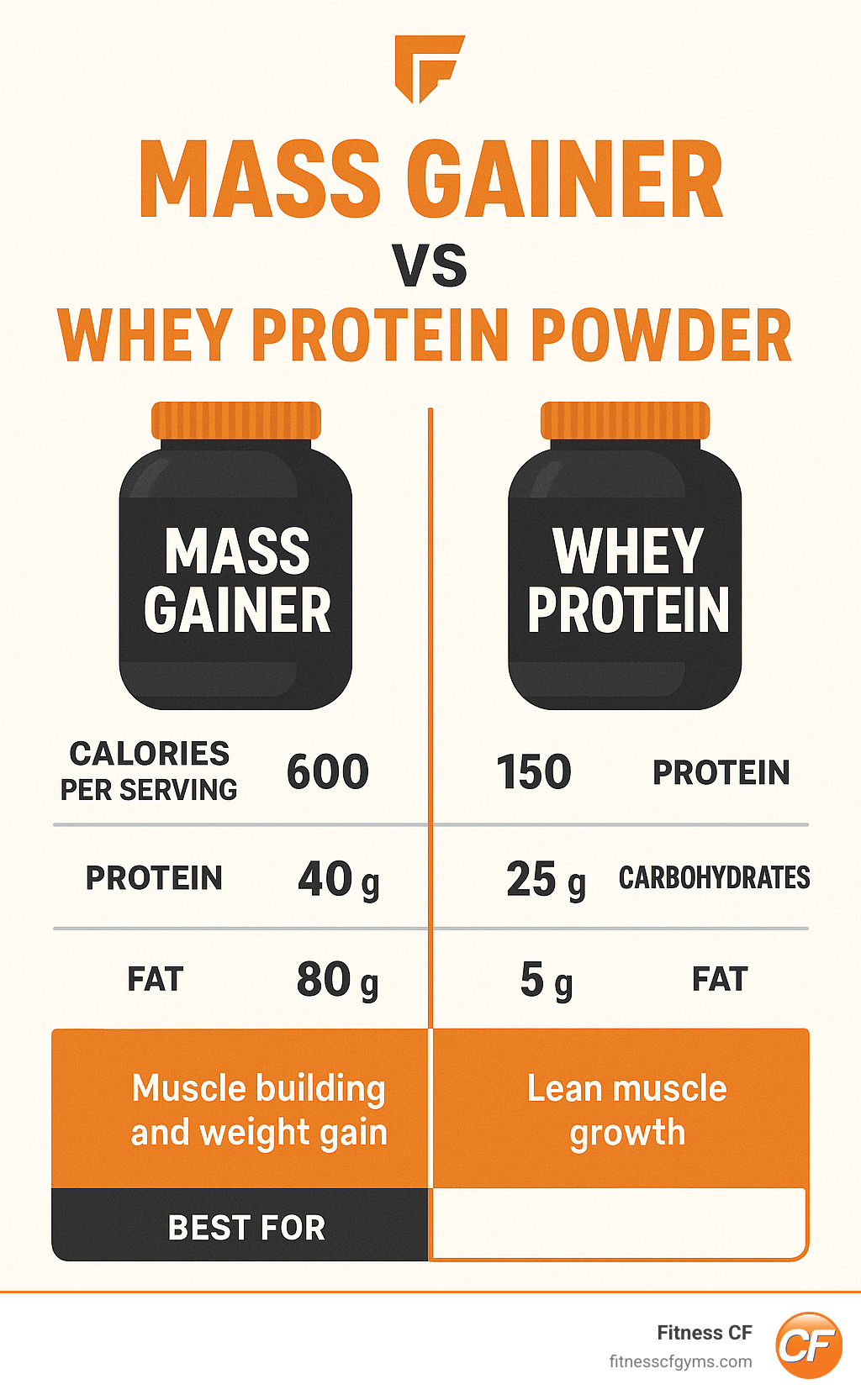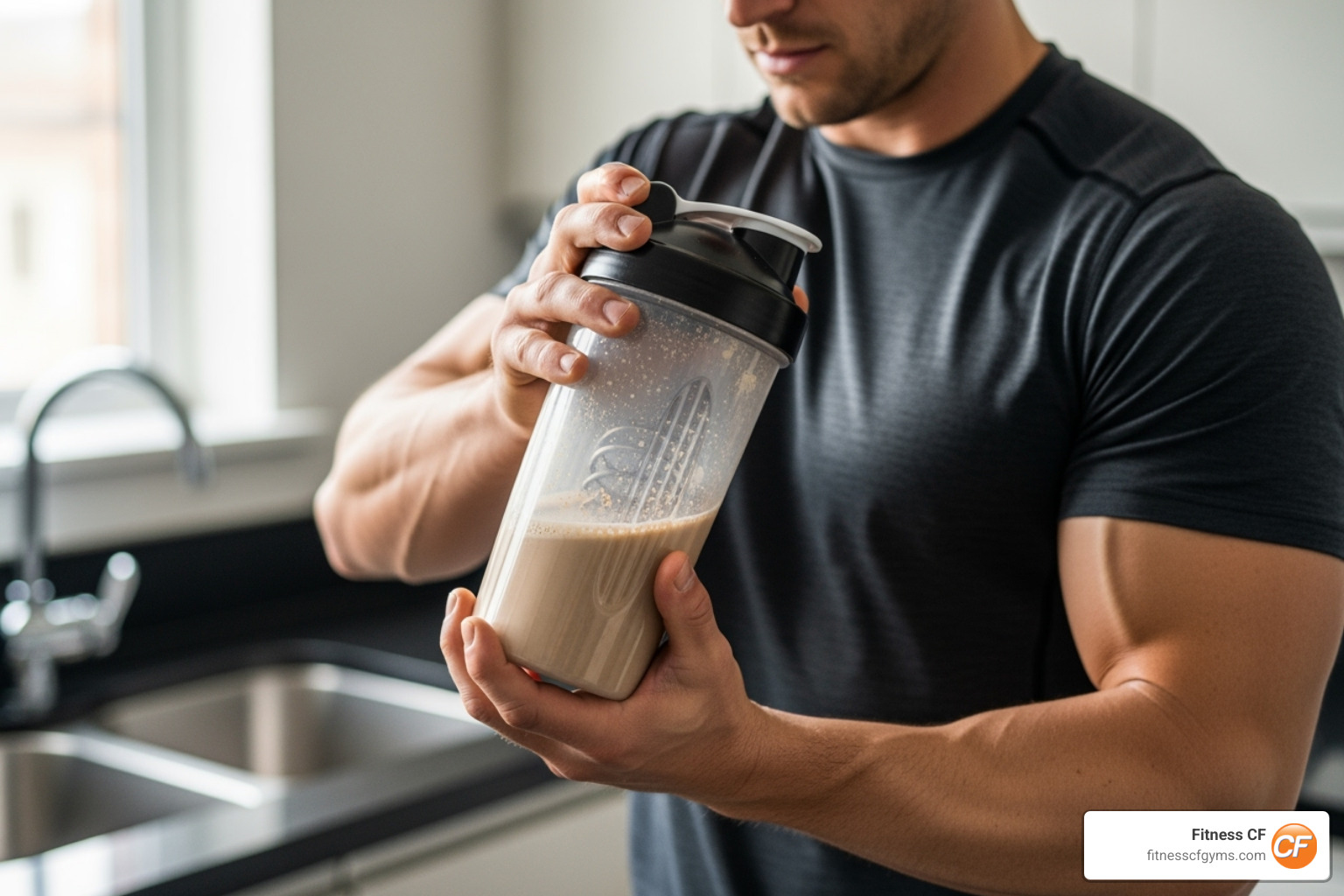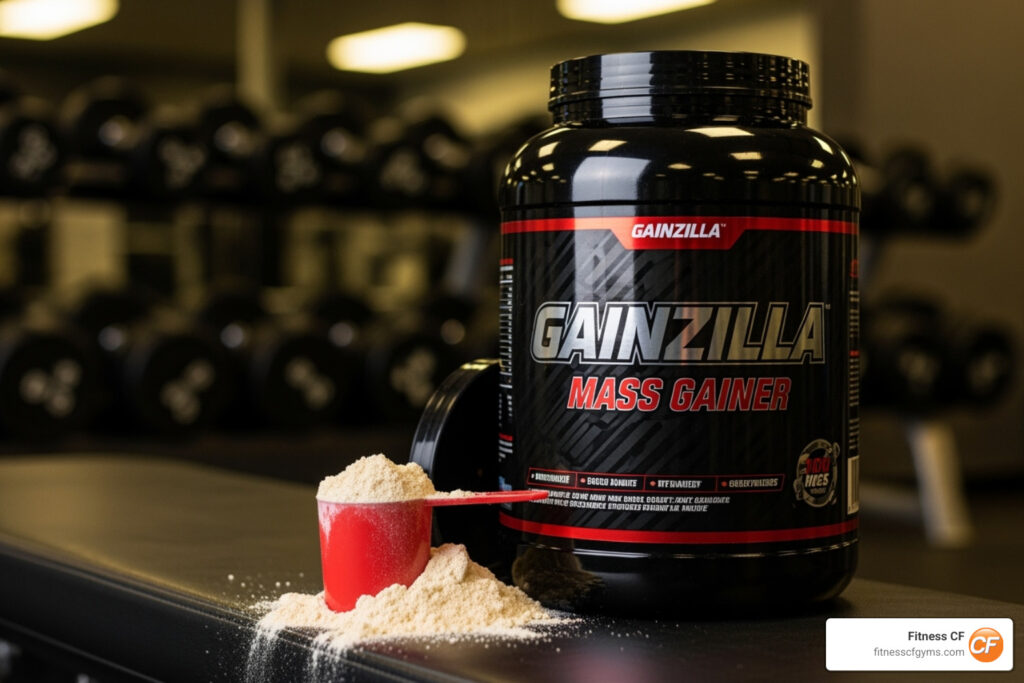Why Mass Gainers Are Essential for Serious Muscle Building
A mass gainer is a high-calorie supplement designed to help you build muscle and size when food alone isn’t enough. These powerful formulas combine protein, carbohydrates, and fats to support weight gain, often packing 300-1,200 calories per serving.
Key Mass Gainer Benefits:
- High Calorie Density: Easily consume 1,000+ calories in a single shake.
- Convenience: Get quick nutrition by mixing with water or milk.
- Muscle Recovery: Protein helps repair and build muscle tissue after workouts.
- Cost-Effective: Often cheaper per calorie than equivalent whole foods.
- Ideal for Hard Gainers: Perfect for those who struggle to eat enough to gain weight.
Mass gainers work by helping you create the caloric surplus needed to build muscle. Consuming thousands of calories daily through whole foods is challenging, which is where the convenience of a mass gainer becomes invaluable.
Who benefits most from mass gainers?
- Hard gainers with fast metabolisms
- Athletes with high energy demands
- Anyone needing to gain healthy weight
- Busy individuals who struggle to eat enough
I’m Pleasant Lewis, and with over 40 years in the fitness industry, I’ve seen how the right mass gainer can transform someone’s ability to build muscle when combined with proper training and dedication.

Learn more about mass gainer:
- fast bulking tips
- muscle building tips for fat guys
- nutrition tips for building muscle and losing fat
What is a Mass Gainer and How Does It Work?
For many people, eating enough calories to gain weight is a daily challenge. A mass gainer offers a convenient solution. It’s a high-calorie supplement powder that combines protein, carbohydrates, and healthy fats to help you achieve the caloric surplus your body needs for muscle growth.
To build new muscle, your body needs two things: building materials (protein) and energy to power the construction (carbs and fats). A mass gainer provides both in a single, easy-to-consume shake, often delivering 500-1,200 calories per serving.
The carbohydrates in your mass gainer serve as your body’s main fuel, replenishing energy stores (glycogen) that are depleted during intense workouts. This allows the protein to be used specifically for muscle repair and growth. Without enough carbs for energy, your body might break down precious protein instead, hindering your progress.
The convenience factor is a major advantage. Instead of forcing down another large meal, you get easier calorie consumption in a liquid form. For anyone serious about building strength, understanding how mass gainers complement your training is crucial. Check out What is Strength Training and What Are Its Benefits? to see how resistance training and smart supplementation work together for weight gain support.
Who Should Consider a Mass Gainer?
While not for everyone, a mass gainer can be a game-changer for specific groups.
- Hard gainers: Individuals with fast metabolisms (ectomorphs) who struggle to gain weight can finally achieve the caloric surplus needed for growth.
- Athletes: Those with high training volumes burn massive amounts of calories and can use a mass gainer to ensure they have enough fuel for performance and recovery.
- Beginners: New lifters who find it difficult to eat enough can use a mass gainer to fuel their workouts and recovery right from the start.
- Individuals needing to gain weight: For health reasons, such as recovering from an illness, a mass gainer offers a dense and easy source of calories.
The key is that the supplement only works if you do. You must challenge your body with progressive resistance training to signal the need for muscle growth. For more strategies, our Fast Bulking Tips guide offers additional insights.
Potential Benefits and Drawbacks
Mass gainers are powerful tools with both pros and cons.
The Benefits:
- Convenient Calories: Getting 800-1,200 calories from a quick shake is easier than eating multiple large meals.
- Cost-Effective: The cost per calorie is often lower than that of whole foods.
- Muscle Recovery Support: The blend of carbs and protein helps muscles recover faster after tough workouts.
The Drawbacks:
- Digestive Issues: The high calorie density can cause bloating or stomach discomfort for some. Splitting servings can help mitigate this.
- Unwanted Fat Gain: A caloric surplus is necessary, but too large of one will lead to fat storage. You must pair intake with intense training.
- Lacks Micronutrients: Mass gainers are high in macros but can’t replace the vitamins and minerals from a balanced diet of whole foods.
Health considerations are important. We always recommend consulting a physician before starting any daily supplement routine, especially if you have underlying health conditions. A mass gainer is a supplement to your diet, not a replacement for it.
How to Choose the Right Mass Gainer for You
Picking the right mass gainer means matching the supplement to your unique needs. Consider your fitness goals, body type, and dietary needs before choosing a product.
If you’re a hard gainer, a high-calorie formula might be best. If you gain weight easily, a “lean gainer” with fewer calories and a higher protein-to-carb ratio is a smarter choice. For dietary restrictions, options like lactose-free or plant-based gainers are available.
Always reading the label is crucial. Look beyond the calorie count to examine the protein sources, carbohydrate types, and any added ingredients like creatine or digestive enzymes. For an extra layer of quality assurance, look for products with third-party testing, which verifies purity and potency.
Choosing the right mass gainer should make reaching your goals easier. For more guidance, check out our Effective Tips for Building Lean Muscle Mass.
Key Ingredients to Look For
When scanning the label, look for these key ingredients that separate quality formulas from mediocre ones:
- Protein Sources: A blend of fast-acting whey and slow-digesting casein provides a sustained release of amino acids to fuel muscle growth.
- Carbohydrate Sources: Quality formulas use complex carbs like oat flour or sweet potato powder for sustained energy, not just simple sugars.
- Healthy Fats: Sources like MCTs (Medium Chain Triglycerides) provide a clean energy source and support hormone production.
- Creatine Monohydrate: An added 3-10g of creatine, one of the most proven supplements, can boost strength and performance. See the Research on creatine supplementation for more details.
- BCAAs: Extra Branched-Chain Amino Acids can further support muscle recovery.
- Digestive Enzymes: Ingredients like Digezyme can reduce bloating and improve nutrient absorption.
- Vitamins and Minerals: A vitamin and mineral blend helps cover any nutritional gaps in your diet.
Understanding Different Types of Mass Gainer
Not all mass gainers are the same. Here are the main categories:
- High-Calorie Gainers: With over 1,000 calories per serving, these are designed for extreme hard gainers who struggle to gain any weight.
- Lean Gainers: These offer under 1,000 calories with a more balanced protein-to-carb ratio, ideal for clean muscle growth while minimizing fat gain.
- Vegan Mass Gainers: Using plant-based proteins like pea and rice, these formulas prove you don’t need animal products to build mass.
- Natural Ingredient Options: These focus on whole-food ingredients and avoid artificial sweeteners, colors, or additives.
- Low-Sugar Formulas: These rely on complex carbs and healthy fats for calories, making them suitable for those wanting to avoid sugar spikes.
The Importance of the Protein-to-Carbohydrate Ratio
The ratio of protein to carbohydrates is a critical, often overlooked, detail. Most mass gainers are carb-heavy for a reason, with typical ratios of 1:5 (protein to carbs) for traditional bulking or 1:3 for leaner gain.
Why is this important? Carbohydrates fuel your workouts and replenish your muscle glycogen stores afterward. This process “spares” the protein you consume, allowing it to be used for its primary job: repairing and building new muscle tissue. Without enough carbs, your body may burn protein for energy instead.
Choose a ratio that aligns with your metabolism. A hard gainer may need a 1:5 ratio for maximum energy, while someone focused on lean gains might prefer a 1:3 ratio for more controlled calories. Understanding this balance is key to making a mass gainer work for you. For more on nutrient timing, explore The Role of Nutrition in Fitness: What to Eat Before and After a Workout.
How to Use Mass Gainers Effectively
Once you’ve chosen a mass gainer, using it correctly is key to seeing results.

Start by following the recommended serving size on the label. For mixing, water is a simple, lower-calorie option, while milk (dairy or plant-based) adds extra calories and protein. You can also blend in fruit, oats, or nut butter for an even bigger nutritional boost.
Most importantly, track your calories. A mass gainer should fit into your total daily intake to create a moderate caloric surplus of 300-500 calories. This is the sweet spot for building muscle while minimizing fat gain. Use a food journal or app to ensure you’re hitting your targets. For more tips, see our Nutrition Tips for Building Muscle and Losing Fat.
When is the Best Time to Take a Mass Gainer?
While you can take it anytime, certain windows offer distinct advantages:
- Post-Workout: This is the most popular time. After training, your muscles are primed to absorb the fast-acting carbs and protein for recovery and growth. Learn more about What to Eat After a Workout.
- Between Meals: A shake can provide extra calories during the day without the fullness of a solid meal, helping you maintain a consistent surplus.
- Pre-Workout: Consuming a shake 60-90 minutes before training can provide sustained energy for your session.
For very high-calorie gainers, consider splitting the serving into two smaller shakes throughout the day to improve digestion.
Integrating with Your Training and Diet
A mass gainer is a tool, not a magic solution. It works best when supporting an already solid foundation.
- Whole Foods First: Your diet should be built on lean meats, fish, eggs, whole grains, fruits, and vegetables. Use a mass gainer to fill the caloric gaps that whole foods can’t. Our Lean Muscle Diet: Your Complete Guide to Foods That Deliver can help you build that foundation.
- Pair with Resistance Training: You must provide a stimulus for muscle growth. Consistent, challenging weight training tells your body to use the extra calories to build muscle, not store fat. Ensure your workouts are effective with these Best Strength Training Exercises to Add to Your Routine.
- Prioritize Recovery: Muscle growth happens when you rest. Aim for 7-9 hours of quality sleep per night and stay well-hydrated to support every bodily function, from nutrient transport to repair.
Frequently Asked Questions about Mass Gainers
I’ve been in the fitness industry for four decades, and mass gainers always bring up a lot of questions. Here are the most common ones I hear from members at Fitness CF.
Do mass gainers actually work?
Yes, mass gainers work by providing the calories needed to create a caloric surplus, which is essential for gaining weight. However, their effectiveness is entirely dependent on being used alongside a consistent resistance training program and adequate recovery. The gainer provides the materials, but your training provides the reason to build muscle.
Can mass gainers cause you to gain fat?
Yes, absolutely. If you consume more calories—from any source—than your body needs for daily energy and muscle repair, the excess will be stored as fat. To avoid this, aim for a moderate surplus of 300-500 calories above your maintenance level and ensure your training intensity matches your intake.
Should I take a mass gainer every day?
This depends on your individual needs. If you consistently struggle to meet your high-calorie targets through whole foods alone, daily use can be an effective strategy. For others, using a mass gainer only on training days or as an occasional meal replacement may be sufficient. It should always supplement, not replace, a balanced diet. Before starting any daily supplement routine, it’s wise to consult with a nutritionist or physician.
Conclusion
Building muscle is a rewarding journey, and a mass gainer can be a valuable tool to help you reach your goals. It offers a practical solution for hitting high-calorie targets, especially for hard gainers or athletes with demanding schedules.
The key takeaway is that a mass gainer is a supplement, not a shortcut. True success comes from a holistic fitness approach that combines smart nutrition with consistent effort. Your workouts provide the stimulus for growth, while the gainer supplies the raw materials. For more motivation, check out these 7 Compelling Reasons to Strength Train.
At Fitness CF, we’ve seen countless members transform their physiques by understanding that supplements are tools to support their hard work in the gym. A mass gainer helps you hit your numbers, but the real work is what builds lasting results.
Your fitness journey is unique, and we’re here to support it. With the right knowledge, you can make this powerful tool work for you.









